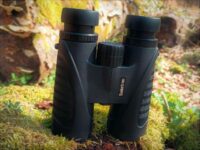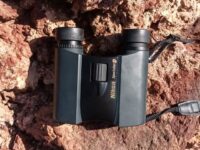This post contains affiliate links. If you follow a link I may earn a small commission at no extra cost for you.
Uscamel is a trademark of Hong Kong-based Karstone Technology Co. Limited, which distributes consumer and industrial electronics. I purchased these Uscamel 10×42 Binoculars for a trip to the tropics. Let’s see how they performed and compare them to other budget binoculars.
Uscamel 10×42 Binoculars

Talking about budget binoculars, these popular Uscamel 10×42 binoculars are a real bargain, you will hardly find waterproof 10 x 42 binoculars at a lower price.
But what about the finish, handling, and optical performance of the instrument?
The package also includes useful extras such as a carrying strap, a storage bag, and eyepiece and lens protection caps. Oh, and also a small manual and a microfiber cloth.
Specifications of Uscamel 10×42 Binoculars
| Optical Glass | HD Glass |
| Lens Coating | Fully Multi-coated |
| Prism type | BaK4 |
| Magnification | 10x |
| Objective diameter | 42 mm |
| Exit pupil | 4 mm |
| Eye relief | 15 mm |
| Field of view | 303ft/1000yds (93m/1000m) |
| Close focus | 10 feet 3 meter |
| Twilight factor | 20 |
| Waterproof | O-ring sealed, Nitrogen filled |
| Weight | 22 oz/ 630 gr |
First Impression of the Uscamel 10×42 Binoculars
When you unpack Uscamel and hold it in your hand it looks like all other binoculars. Seems to be well made, nothing wobbles, and it feels well-balanced in the hand and makes a good first impression.
But that’s what you should be able to expect from most optical devices these days: With the help of CAD and computer-controlled production systems, precise housings and mechanics can now be manufactured quickly, inexpensively and precisely.
The real quality of a pair of binoculars, of course, depends on the inner workings of the best optical glasses and the well-coordinated optical parameters of these.

The Binoculars Housing
The body of these roof prism binoculars does not differ much from the many other 10 x 42 binocular models. The binocular tubes are connected via a middle bridge, and the hinge of the middle bridge moves gently and evenly.
It is lightweight thanks to the polycarbonate material used for the housing. The housing is protected by rubber armoring. Attached rubber eyepiece caps and lens caps do provide additional protection during transport or storage.
Waterproof Fog Proof
According to the manufacturer, the housing is waterproof and nitrogen-filled. If you look into the lens barrel you will see an O-ring on the lens. When focusing, the lens slides back and forth on this o-ring.
Whether that is as durable as a statically mounted and o-ring sealed glass pane remains to be seen. I would expect that, especially in a very dusty environment where e.g. there is a lot of fine sand dust or something, but there is wear and abrasion on the constantly moving O-rings and the binoculars then lose their water resistance and also the nitrogen filling.
The manufacturer’s data sheet specifies IPX4 as the waterproof rating, which means that it is splash-proof but not waterproof if it is submerged.
Update: I’ve been using the binoculars here in the tropics for a good six months now. It was exposed to rain, I took it with me to the sea, it just hasn’t fallen into the water yet. The humidity here is extremely high, always over 90%. So far it has shown no sign of fogging or moisture inside. But I have to admit that the temperature fluctuations are not extreme. So I can’t say how the binoculars behave in the extreme temperature fluctuations and how internal fogging may then occur. In such environments, binoculars with an IPX7 rating such as the CStdar 10×42 might be more reliable.
Dimensions and Weight
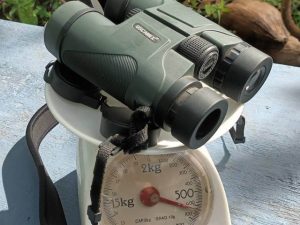
The dimensions of this US Camel are pretty much comparable to the average dimensions of 10×42 binoculars. In terms of weight, my scales show something around 600 grams, that’s a good 21 ounces.
It is weighed with the eyepiece caps, lens caps, and carrying strap, but I have to weigh it again with another scale.
Can I mount the binoculars on a tripod?
It is always very useful if binoculars also have a screw thread to which a tripod adapter can be attached. You find the same as usual at the objective side of the middle bridge.
This is practical because you can easily attach it to a tripod. In this way, long-term animal observation can be comfortably endured without tiring the arm. A tripod is also extremely practical for digiscoping, so you can easily look at your cell phone and take photos or films without the recordings becoming blurred.
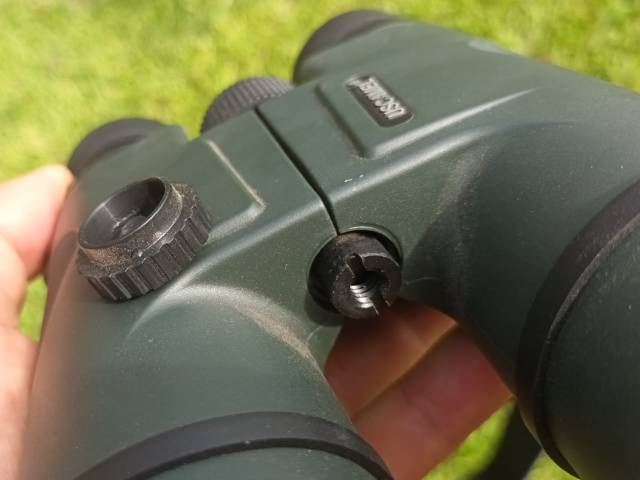
The Mechanics
Good workmanship and precise manufacture of the moving parts are the prerequisites for the binoculars to function reliably and be fun to use.
Focus Wheel
The large center focus wheel is offset forward on the eye side of the binoculars. It is easy to reach with your index or middle finger and rotates evenly and gently. From very close range (about 12 feet) to infinity it takes about one and a quarter turns.
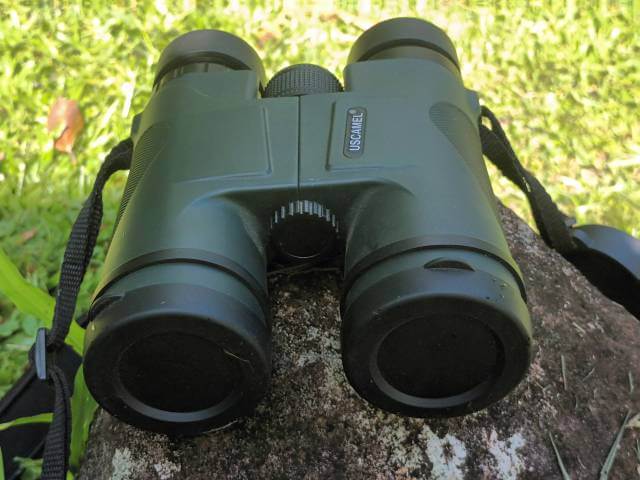
Middle Bridge & Hinge
It sports a simple but wide central bridge that hinges gently and evenly without jerking and allows for an eye distance to be adjusted from 58 mm to 64 mm. This is wide enough to allow kids to use the binoculars as well as people with very wide faces.
Eyecups and Diopter Compensation
The eyecups can be extended out by a good third of an inch. This is necessary for people who don’t wear glasses because when the eyecups are folded in, there is a kidney bean effect on the edges of the field of vision. Half out you feel a slight resistance but it doesn’t really snap. Even if they are completely extended out, they don’t snap in properly they tend to de-adjust themself quite easily. It’s a bit flimsy, the manufacturer could improve something here.
If you have a slight difference in vision between your eyes, you can use the diopter compensation on the right eyepiece for fine adjustment to focus optimally.
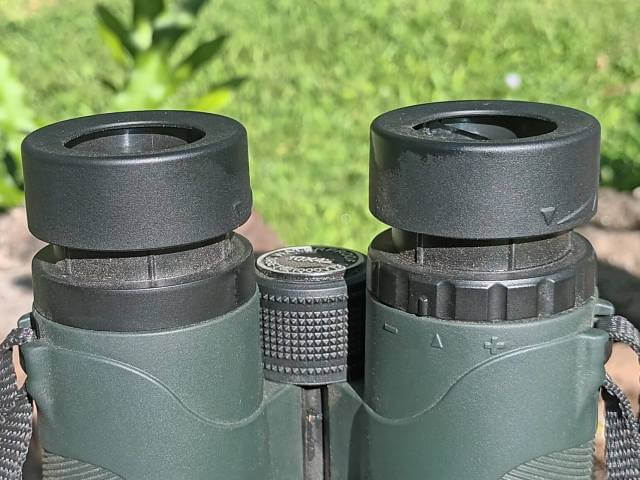
Optical Performance
When it comes to optical performance, it becomes critical for binoculars. This is where the cheap, middle priced, and expensive binoculars show their differences. Especially with optical devices such as camera lenses or glasses (how much do good glasses from an optician cost?) applies: you get what you pay for. So if you only spend a little money on binoculars, you have to be satisfied with inferior optical performance.
On the other hand, one must not forget that most hobby users do not necessarily need premium binoculars, as they do not have the same expectations as professional users who demand the best optical performance.

Magnification and Lens size
10x magnification combined with a 42mm entry lens is one of the most popular binocular sizes. Binoculars with these specifications are all-around glasses that are ideal for any situation. The 42mm lens collects a lot of light so you can see use these binos even in twilight or low light, while the 10x magnification allows for nice detailed observations.
Lens Coating
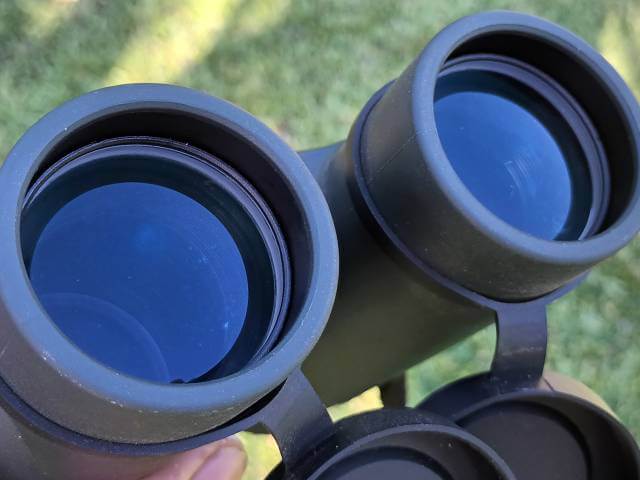
The manufacturer advertises in the product description that the lenses are fully multi-coated.
Multi-coated refers to a process in which multiple layers of anti-reflective coatings are applied to optical glass lenses to enhance the transmission of light and clarity of the image. Anti-reflective coatings help to reduce light loss due to reflection, resulting in improved contrast and brighter colors. The coatings also reduce glare, enabling users to view images in low–light conditions.
If you hold the lens so that the light is reflected in it, you can see a faint greenish shimmering reflection on the lens. Looking straight into the tube, the view is clear and there are no discernible color deviations.
If you point the binoculars at a white house wall in the midday sun, it appears in the same shade of white as if you were looking at it with the naked eye.
Prisms

According to the specifications, the binoculars have BaK-4 prisms. This is evident when holding the binoculars against the bright sky and looking at the exit pupil. It’s nice and round.
Unfortunately, there is no indication in the specifications whether the prisms are phase-corrected and whether they are vapor-coated or dielectrically-coated. But if you take into account the super low price, you can assume a simple aluminum coating. The simple coating of the prisms is also evident in the optical performance, the edge blur, the slight color fringes, and the not spectacular contrast.
Eye Relief
In the specifications, the eye relief is given as 15 mm, that’s okay. When I use the binoculars, I screw the eyecups all the way to get the best view.
Close Focus
When testing at close range, I was able to focus on objects from about 9 feet away.
Unfortunately, the manufacturer forgot to include this information in the product specification.
Collimation
The images of the tubes merge well. No double images either at close range or at far distances.
Optical Distortion
When lenses magnify objects, the magnification is not uniform but can be slightly distorted. Distortion has to do with the shape of the optical lenses and the optical laws according to which the light behaves and passes through the lens.
The effect is a decrease or an increase in magnification from the center of the image to the edge of the image, which is best seen by looking at a straight object and then slowly moving the binoculars up and down, watching the object bend.
The less distortion the better but the more expensive the optics get. The percentage of pincushion distortion in low-budget binoculars can vary greatly, depending on the quality and brand. Generally, budget binoculars may have anywhere from 1-5% of pincushion distortion.
The percentage value of pincushion distortion refers to the amount of distortion present in the image when viewed through binoculars. It is measured by comparing the size of the image in the center of the view and at the edge of the view, and the difference between the two values is the amount of pincushion distortion present.
With cheap binoculars, there is usually a pincushion distortion, but this is not noticeable to every observer if one is not looking for it. Because with normal observation, the observer’s brain focuses on the middle of the field of view where the effect does not occur. This center-focused vision is also why edge blur isn’t noticeable to every user.
Distortion
In this shot, you can see quite clearly that the power lines in the middle field of view run evenly parallel but then bend outwards towards the edge. A not-too-weak pincushion distortion.
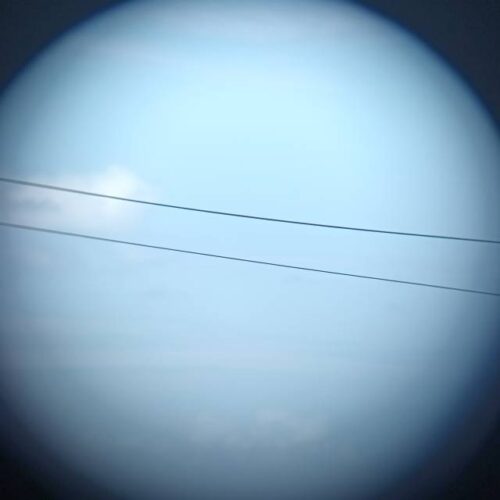
Edge sharpness and Edge Blurring
If the field of view is focused in the middle and you move your gaze to the edge you will see that the sharpness decreases, this is called edge blur or spherical aberration.
This effect also becomes quite clear if you look for it. Fortunately, as explained above, the brain concentrates on the middle field of view, and one always pans interesting objects into the middle field of view. At this price of the instrument, there is really nothing to complain about.

Chromatic Aberration / Color Fringing
Chromatic aberration occurs in this model at the light-dark contrast. the stronger the light-dark contrast, the more pronounced the chromatic aberration. You can see that again on the power lines. However, if you look at objects where the light-dark contrast is not so extreme, the effect is only very weak. A phase-correcting prism coating in combination with ED glass would further reduce the effect but also add another 0 to the price tag.
Color fidelity
Colorful objects appear through the binoculars in the same hue as seen with the naked eye.
Pros of the Uscamel 10×42 Binoculars
- Extremely low purchase price
- Adequate optical performance
- Flawless mechanics
- Waterproof
- Accessories: eyepiece and lens covers, cleaning cloth, padded carry case, neck-straps
Cons
- Flimsy eyecups, don’t really snap-in
- Chromatic aberration
- Pincushion distortion
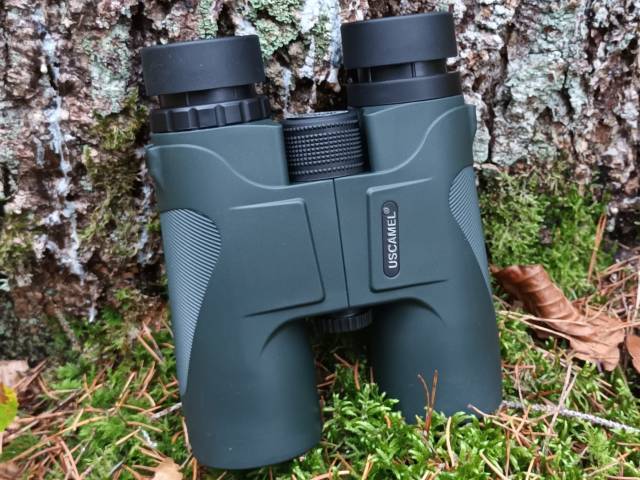
Using The Uscamel 10×42 Binoculars
I’ve had the binoculars for a good six months and use them almost every day here in the tropics. So far so good I can’t complain, it’s practical and does the job. It has been exposed to rain and also saltwater spray during boat trips, no problems with it so far.
In summary,looking through the US Camel 10 x 42 reveals bright, true-color images but with clearly visible chromatic aberration. Handling and focusing is quick and easy, the central image area is sharp, towards the edges blurring is apparent, and panning the view up and down the horizon pincushion distortion is clearly visible. |
Who is The Uscamel 10×42 Binoculars For
The Uscamel 10×42 Binoculars are an ideal choice for anyone looking for a low-cost pair of binoculars. This also makes a great gift as a child’s first pair of binoculars. Being waterproof and featuring 10x magnification and 42mm objective lenses, these binoculars are perfect for a variety of outdoor activities such as bird watching, wildlife observation, hunting, and stargazing.
The optics of the Uscamel 10×42 Binoculars deliver bright and acceptable images, not comparable to $1000 Leica binoculars, but considering the low price this is perfectly fine for people who don’t expect top performance.
Admittedly, an expert marksman will not be impressed by this binocular, and you can’t impress your fellow huntsmen with it either. But for the average person who does not value extreme edge sharpness or who does not care whether color errors are also quite strong in the middle field of view (if the user notices it at all), these binoculars are a real bargain and for the price, you can be enthusiastic as far as optical performance is concerned. All in all a great deal for little money.
No products found.

